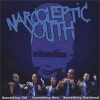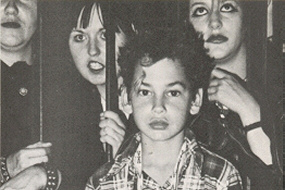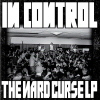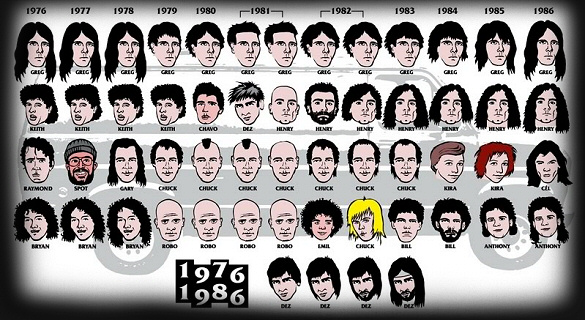Narcoleptic Youth – Something Old, Something New, Something Borrowed
January 28, 2010
 I’ve always found Colorado to be somewhat boring. The last time I was there visiting family, I made it a priority to find a good record store that is similar to the ones we have in Orange County. We found one that reminded me of Orange County so it felt like home. They had band posters everywhere, show listings, t-shirts, etc. Not to mention they had a great selection of used Punk rock music. I just wish I remembered the name of the record store!
I’ve always found Colorado to be somewhat boring. The last time I was there visiting family, I made it a priority to find a good record store that is similar to the ones we have in Orange County. We found one that reminded me of Orange County so it felt like home. They had band posters everywhere, show listings, t-shirts, etc. Not to mention they had a great selection of used Punk rock music. I just wish I remembered the name of the record store!
I bought several CD’s that day, one being Something Old, Something New, Something Borrowed from Narcoleptic Youth. It was only 5 dollars so how could I resist? It was released on Gale Force Records in 2004. So when this disc came out, the first four tracks were considered “new”. It opens with Dear John (Don’t Drink the Punch), which happens to be one of my favorites. If you’ve seen Narcoleptic Youth before, it’s a pretty well known song that they often play live. It’s followed by Black 11, One More Saki, and Feel the Sickness. The next two tracks are “borrowed”. Narcoleptic Youth covers Bullet by The Misfits and Ignite by The Damned. Ignite is actually my other favorite on this CD. They did one hell of a job covering this song. Joey Bondage almost sounds just like the Damned vocalist, Dave Vanian. The last five tracks are “old” and are live recordings from 1998 at the Orange Pavilion in San Bernardino. The last track, Double Jointed Circus Monkey, has what you can call a secret track. It features around 30 seconds of them covering Manny, Moe, and Jack from the Dickies, them attempting to record Bullet, and of course some messing around making funny voices.
Overall, this is a pretty cool CD. If you’re a fan of Narcoleptic Youth, I suggest you check it out. You’ll easily be drawn to it.
-Corrina P.-
Music scene reporter
Big Wheel Online Magazine
Music from the Used Record Bin
Check out other records in the used bin HERE
In Defense of Punk Rock
January 26, 2010
 Most of us who are into Punk rock initially got involved in the movement at some point in our teenage years. With acne on our faces, foam dripping from our mouths and giant chips on our shoulders we found excitement in music that was loud, full of energy, and completely anti authority. The excitement and fear that is associated with going to a Punk show for the first time is an unusual and unfamiliar feeling that leaves you constantly seeking the same sort of experience over and over again. Young punks become adrenaline and testosterone addicts much to the chagrin of their parents and teachers who pray that Punk rock will be a phase that passes quickly.
Most of us who are into Punk rock initially got involved in the movement at some point in our teenage years. With acne on our faces, foam dripping from our mouths and giant chips on our shoulders we found excitement in music that was loud, full of energy, and completely anti authority. The excitement and fear that is associated with going to a Punk show for the first time is an unusual and unfamiliar feeling that leaves you constantly seeking the same sort of experience over and over again. Young punks become adrenaline and testosterone addicts much to the chagrin of their parents and teachers who pray that Punk rock will be a phase that passes quickly.
Records are bought, clothes are mutilated, hair gets sheered off or spiked up and dyed day glo colors. Somewhere along the line most punks find however that beyond the image and blasting guitars that being punk rock has deeper implications. Instead of just a uniform and musical style, Punk becomes a vehicle to reevaluate society and all of its roles. While there are many different cliques and sub tribes within Punk rock, all serious members of the culture have come to similar conclusions- that the world has become seriously fucked up as the result of mindless consumerism and abuses of power committed by establishments that were created long before any of us were born. As a result we respond in our own ways- some Punks become politicized while others reject their surroundings in purely social ways. Whatever form this rebellion takes on, one can be assured that people everywhere will notice the loud statements that punks make and will often respond with even more anger and hatred, further reinforcing a sense of alienation from society that almost all Punks have felt.
If all of this sounds like madness that's because it is. The Punk rock lifestyle is often overwhelming and exhausting. It can sometimes be a lonely path to walk but it seems that once you're in there is often back. When a mindset is changed radically it can be difficult if not impossible to go back to looking at life in a simpler and less antagonistic way. Yet inevitably as high school graduation approaches punks start dropping like flies, trading in the lifestyle for something that is more relaxed and seems more rewarding. As kids go to college they often pick up their class schedules and drop their Dead Kennedys records on their way.
Transitioning to the other side of society and crossing the line drawn in the sand to the side of the enemy must be a strange feeling, but like Joe Strummer said "He who fucks nuns will later join the Church." Of course it is understandable that people will change with age and find new interests and perhaps yet another new way to look at the world. At the same time though mainstream society seems so empty and void of substance and feeling. Maybe after years of spitting at the world that lack of substance and passion is exactly what some people go looking for. It might be easy just running on autopilot for a while.
Almost any Punk band that makes more than two or three full length records ends up becoming tame with time. The rawness of most Punk bands in their early stages is exciting and captivating. By the time most of these bands start to smell success though they seem to lose their desire to scream out their guts and emotions and those now empty guts seem to become hungry for a commercial reward. Bands who were once loved for playing raw and pure Punk rock rarely sound better when they turn their music into a more polished, sophisticated and "mature" product. The result is usually more disgusting than appealing and so all you old Punks who gripe about how your fan bases turned on you when you changed your sound, I have no sympathy. The so called "evolution" of bands usually adds up to a whole lot bullshit. If you want to make music that isn't Punk don't blame us when we turn your backs on you. Just like you once did we spit out the poison that society and the music industry tried feeding us because we didn't like it. It should be no surprise that when you try to emulate the "rock" music that we hate, that we want nothing to do with your fourth record. Don't forget you were once one of us.
The music industry as it stands offers nothing interesting or appealing to people who are looking for music that is energizing or thought provoking. Large venues gouge audiences' wallets while offering a less friendly and more anonymous experience. Why would someone want to pay sixty dollars to see a band play in a stadium rather than paying eight dollars to see a Punk band in a small space with a bunch of close friends? Overall the experience of seeing a big rock band is generally uninspiring and not engaging. At Punk shows people run around, singing along, and jumping on and off stage with bands playing. Admission is rarely more than ten dollars, records are almost never than twelve, and a T shirt that costs fifteen dollars is considered to be a complete rip off. It is not abnormal to go to a big concert and pay sixty to eighty dollars for a ticket, ten dollars for parking, six dollars for a hot dog, thirty dollars for a T shirt, and end up being nowhere close to the band. Meanwhile macho assholes who are trying to prove that they know how to "rock out" pick fights and throw up on the ground.
When people express a concern over the decline of the music industry it's hard not to laugh. That old beast is long past its expiration date and things have smelled rotten for a long time. In a last ditch effort major ticketing agencies and record labels are consolidating in an attempt to join forces in an evil alliance to survive a few years longer. Little good has ever come out of the commercialization of music. Perhaps the only interesting innovation that has ever come from those fuckers in their mansions on the hills is the "Wall of Sound" technique of recording that Phil Spector created when he was a key player in the music industry and look out how that old bastard turned out. Otherwise no great innovation has ever come out of the music industry that couldn't have been created in a less commercial atmosphere. The industry does not create music- it simply creates an outlet for products that more often than not probably would have been better if they were created in a more nurturing environment.
If the music industry ever collapses I will say goodbye with a "So long! Wish I could say it was nice knowing you." Make no mistake or misjudgment - if there were no commercial music industry that by no means would ever mean that there would be no music. One can guarantee with confidence that Punk rock would not suffer. In fact one could assume that if the playing field were leveled that few of the so called artists who are enjoying popularity now would still be successful when people actually began to seek out music rather than just having it served to them by mainstream media. Perhaps if this were the case people would learn what Punks have known all along- that the deeper a connection that one has to the roots of the music that they listen to the more satisfying it is to enjoy.
In short while I have learned to never expect that people who get involved with Punk rock at a young age will stick around for half as long as they say they will, let me remind our readers that at some point everyone involved in the punk movement came in looking for the same things and that the values that punk rock represents are still vital and important. While at times punk might seem juvenile, rehearsed, and perhaps even insignificant, know that we are fighting a good fight in a time of corruption and deceit. This undoubtedly will come off as idealistic, but the only thing that we can really hope to ever do is offer an alternative to mindless society and to do so by living as examples and rebelling in positive and thoughtful ways. To those who feel the need to change I say good luck and I hope that you find what you are looking for, but for those who stick around, give yourselves a pat on back and know that you are a part of something meaningful.
-Ditch-
Asst. Editor
Big Wheel Online Magazine
In Control – The Nard Curse LP
January 26, 2010
 In the Summer of 2002 In Control made it out to the East Coast during their tour of the United States. My buddies and I first caught them at a show in Lawrence, Massachusetts and then went to see them in Boston. A few days later we ended up seeing them again when they were playing in Wilkes Barre, Pennsylvania at the Posi Numbers Fest, which that year also featured the Cro Mags. Prior to these shows I have never heard of In Control, but I was impressed by their music, their enthusiasm, and their crazy live performances. Vocalist, Ryan Fredette sang with no shoes on and on one night he somehow ended up naked and bleeding from his head before the night was done. Over the years I bought a few of their records, including their epic "The Truth Hurts" full length and a cool 7" with their favorite cover songs from bands like Scared Straight, Agression, Blitz, and GG Allen. I seem to remember that this 7" was a major gateway to Nardcore bands in general as aside from Agression that stuff never really got all that well known on the East Coast.
In the Summer of 2002 In Control made it out to the East Coast during their tour of the United States. My buddies and I first caught them at a show in Lawrence, Massachusetts and then went to see them in Boston. A few days later we ended up seeing them again when they were playing in Wilkes Barre, Pennsylvania at the Posi Numbers Fest, which that year also featured the Cro Mags. Prior to these shows I have never heard of In Control, but I was impressed by their music, their enthusiasm, and their crazy live performances. Vocalist, Ryan Fredette sang with no shoes on and on one night he somehow ended up naked and bleeding from his head before the night was done. Over the years I bought a few of their records, including their epic "The Truth Hurts" full length and a cool 7" with their favorite cover songs from bands like Scared Straight, Agression, Blitz, and GG Allen. I seem to remember that this 7" was a major gateway to Nardcore bands in general as aside from Agression that stuff never really got all that well known on the East Coast.
Anyway after that long introduction it might be needless to say that I was stoked to find out that this L.P. of some of In Control's early material had been reissued. I was also stoked to find out that they were playing again and since I am now living in Southern California I definitely thought that it was cool when I recently got to see them play again in the OxNardcore region with Ill Repute. That was pretty epic in itself. The first side of the "Nard Curse L.P." has the songs from In Control's "Hardcore Pride" demo that came out in 1999. The music is hard and fast with some tastefully done heavy mosh parts. In general the sound is a mix of California Hardcore with some heavier, New York style influences. The vocals in particular sound a bit like Warzone. The lyrics are mostly about scene politics and a need for people to take care of each other. As one might expect from a demo, the recording is raw if a bit flat at times, but it still more than passes the test. Highlights include "It Can Happen" with its catchy hardcore chorus and the "Nard-Tro" which is similar to Warzone's "We're The Crew."
The Second side features the "Nard Curse E.P." recordings and opens with "Give Me Some Reality," which is a hard hitting song that got some attention when it came out. The lyrics are simple "You say positive- I say fuck that! Give me some reality." While this might seem a bit reactionary and silly at the time it was cool to hear a band offer an alternative to the rhetoric of ultra posi Youth Crew revival bands who expected everyone in the Hardcore scene to be clean cut and blindly optimistic. "Let It Be" is another cool song with a bit of a melodic edge to it. In general by the time that In Control recorded "The Nard Curse" they had gotten the dynamics of the band down pretty well and they had a very strong balance of heavy mosh parts with faster, more Punk oriented verses, and melodic bass lines though out their songs. It also featured a cool cover of Stalag 13's "Sometime."
One thing that could never be doubted is the pride that In Control had/have in the Nardcore scene. From "Hometown Pride" to "Oxnard Crew," "Nard-Tro" and even their Stalag 13 cover (not to mention taking their name from a Stalag record), In Control made it clear to everyone where they came from.
Band MySpace: www.myspace.com/inxcontrol
Record Label Website: www.6131records.com
-Ditch-
Big Wheel Online Magazine
Go HERE to see all the latest record reviews
Anti-Flag w/ Aiden, Cancer Bats & Broadway Calls – House of Blues Anaheim – Anaheim, CA
January 24, 2010
 After almost a whole day of boredom passing by, at the last minute on Sunday I decided to get ready and head down to House of Blues Anaheim to go see Anti-Flag. I called a cousin to go with me and we rushed down to Downtown Disney hoping that the show wasn’t sold out. Luckily, it wasn’t and we were able to buy our tickets. Outside of the venue, there were a few petitioners from PETA asking people to sign a petition to stop the Canadian Seal Slaughter. Knowing it was for a good cause, I signed the petition before entering the venue and they gave me a free pin with the word fur crossed out.
After almost a whole day of boredom passing by, at the last minute on Sunday I decided to get ready and head down to House of Blues Anaheim to go see Anti-Flag. I called a cousin to go with me and we rushed down to Downtown Disney hoping that the show wasn’t sold out. Luckily, it wasn’t and we were able to buy our tickets. Outside of the venue, there were a few petitioners from PETA asking people to sign a petition to stop the Canadian Seal Slaughter. Knowing it was for a good cause, I signed the petition before entering the venue and they gave me a free pin with the word fur crossed out.
Due to a last minute decision, we missed Broadway Calls. I don’t listen to them so I didn’t feel like I missed much. I overheard conversations from their fans and people who had just heard them and it sounded like they had played a good set. They had a number of fans sporting Broadway Calls t-shirts. Each of the bands that played after them all thanked Broadway Calls for opening the show and the crowd showed their thanks by clapping and cheering.
I arrived during the Cancer Bats set. Just hearing a few seconds of their music reminded me of the Gallows, so I was immediately attracted to their sound. Their music was strong, heavy, and triggered you into wake up mode if you were feeling even the least bit tired. It was so fierce it made you want to clench your fist and punch someone in the face right at that perfect moment, and I’m sure most of you know what I’m talking about. I could hear different genres such as punk, metal, and hardcore all mixed together to come up with the sound the Cancer Bats displayed in their music.

Each member from the Cancer Bats were completely full of vigor. The singer was running back and forth on stage, jumping, and banging his head and even stepped onto the barricade to be more involved with the crowd. The drummer was full of sweat and looked tired while he was playing, and the guitarist and bassist both head banged while playing. I noticed that they attracted some of the emo kids, metal heads, Punks, and even some of the older heads that attended the show. If the fans weren’t pitting, they got heavily into the music by head banging, or they did both. When they announced their last song, the crowd formed a huge circle pit. They left the stage and a lot of people, including myself, wanted to hear more. They are definitely a band worth checking out.

Aiden was up next and the floor cleared up. Now it doesn’t mean that Aiden isn’t good, they just didn’t have as many fans as the Cancer Bats did so the energy was a bit low. One of the first things the singer said was that during Aiden’s 40 minute set, Anaheim had those 40 minutes to prove to them that we were better than Hollywood. As Aiden got started they invited the audience to give them a listen and broaden their music interest. They were very different from the previous band. Aiden was more of a fast-paced emo band with a gothic look. They had 2 pentagram banners set up on each side of the stage. The crowd remained calm but still danced around a bit.

The pit remained small until Aiden did a cover of the Misfits “Die, Die My Darling”. It was different, but Aiden still managed to pull off and excellent cover from a classic Punk band and make it their own. At about half their set, Aiden asked the crowd to spread out to right and left sides of the venue. The crowd was to perform a “wall of death”. The singer, William, stepped off stage and onto the floor to give the crowd an extra boost of energy to participate in this. He walked around in a big circle giving us the rules of the wall of death. Aiden gave their cue, and both sides rushed towards each other to complete the wall of death. It looked like a huge brawl at first, but it soon turned into a giant circle pit that everyone participated in. They played a few more songs, one being “Scavengers of the Damned”, and then called it quits for the night. Aiden never actually let Orange County know if we were better then Hollywood.

Aiden had pumped everyone for Anti-Flag. While anxiously waiting for them to start, people were sitting on the floor talking with their friends and meeting new people who were sitting around them. Eventually, the curtains opened and everyone stood up wile cheering and clapping their hands. Before actually playing a song, bassist Chris #2 made an announcement regarding their vocalist/guitarist, Justin Sane. Justin had a family emergency on Saturday, so they flew him back home so he could be with his family. With that being said, Chris #2 took over for Justin, doing the vocals for all the songs.

Anti-Flag opened up with the famous “The Press Corpse”. It was the perfect opening song. A pit was formed as soon as they started and it literally took up the whole floor. It's a very popular Anti-Flag song that almost everyone knew. Sure enough, fists were raised and everyone chanted “we don’t want to talk about it!” They immediately followed with “Sodom, Gomorrah, Washington D.C.”, a song off their latest album. The crowd was eager to keep the pit going because they managed to keep pitting even for the slower songs. They played older songs such as “Turncoat” and “Underground Network”. Anti-Flag are known to be a very political band, but surprisingly they didn’t do a lot of talking about politics. At one point, Chris #2 asked the crowd, “How many of you know how to play the drums?” He said they needed some volunteers to go up on stage and play with them. So many people excitedly rushed to the front, jumping up and down so that they can on stage. Four guys got on stage and they played cowbells going along to the beat of the song. Anti-Flag played “Fuck Police Brutality” and “Drink, Drank, Punk”, two songs that were released off an album from 1993. Those two songs created the biggest circle pits of the night.
- See related Interview with Chris#2 HERE -

Anti-Flag began playing a slower song, “This Is the End (For You My Friend)”. Towards the end of the song, Chris #2 asked everyone to jump and they received full audience participation. After, they played another famous song, “Die for the Government”. They said goodnight and left the stage, but we all knew it wasn’t over. Sure enough, the band came back out. Chris #2 began playing a bass line that was the beginning of a short medley of songs from The Clash. They started with “The Guns of Brixton” then “I Fought the Law” and ended with “Should I Stay or Should I Go?" It was a fun group of songs to combine and everyone knew the words. Before leaving the stage they had one more surprise for us. The drummer, Pat Thetic got up from behind his drums and made his way down to the floor. His drum techs followed him while carrying his drum set and he set up his drums on the floor. Anti-Flag ended their show with a song called “Power to the Peaceful” and Pat Thetic played the song on the floor with everyone crowded around him. Before leaving the stage, the band moved towards the barricade to shake the hands and greet some of their fans.

Sunday’s show was a great success. It was interesting and different, in a good way. It’s not often to go to a show where each of the bands has a unique sound from the others or where genres are mixed. The bands made it personal, intimate, and more fun for their audience because they actually went down into the crowd. Now how often does that happen?
-Corrina P.-
Big Wheel Music Scene Reporter
More photos of the show can be seen HERE
Go HERE to see all the latest show reviews
The Eyes – T.A.Q.N.
January 24, 2010
 In the past few years record collectors have benefited greatly from Artifix Records' quest to release every great lost recording from the early years of Southern California Punk rock. With access to the complete archives of Dangerhouse Records, Artifix has managed to make some amazing gems see the light of day. The six songs on this 10" include the "TAQN/Topological Lies" tunes, "Disneyland" off the "Yes L.A." comp, and three songs that were not released while the band were together (two otherwise unreleased songs and "Eniwetok" from the 1990's "Gimme A Little Pain" comp).
In the past few years record collectors have benefited greatly from Artifix Records' quest to release every great lost recording from the early years of Southern California Punk rock. With access to the complete archives of Dangerhouse Records, Artifix has managed to make some amazing gems see the light of day. The six songs on this 10" include the "TAQN/Topological Lies" tunes, "Disneyland" off the "Yes L.A." comp, and three songs that were not released while the band were together (two otherwise unreleased songs and "Eniwetok" from the 1990's "Gimme A Little Pain" comp).
All of these songs were recorded in the same 1979 recording session and capture The Eyes playing the way that only The Eyes could play. They managed to fit into the art damage category along with The Screamers and Deadbeats while also maintaining Wavey/Power Pop hooks of the Dils and Dickies. In a way The Eyes come off as a cartoonish caricature of all things that were Punk rock in L.A. and Orange County in the late 1970's. "Disneyland" is of course the band's most memorable track and further reinforces that The Eyes were very much a product of their sunny Southern California environment. All of these songs are quirky, fun, and inexplicably addictive despite the "ear worm" nature of a band who have an organist who often plays parts that barely go along with the guitars and a singer who sounds about nine years old. The two unreleased songs are about bees ("Research Bee" and "Go Go Bee")- who knows what was going on with that. I don't do drugs but I think I might Take A Qualude Now.
Artifx Records Website: www.artifixrecords.com
-Ditch-
Big Wheel Online Magazine
Go HERE to see all the latest record reviews
Spray Paint the Walls – The Story Of Black Flag
January 24, 2010
 Once while in high school I was discussing the legacy and mysterious aura of Black Flag with a couple of friends and I paused to say "Dude, there's only so much that we know about Black Flag." At the time this statement was fairly accurate. Henry Rollins had published his tour diaries from when he was in the band in Get In The Van but otherwise there was seemingly no information available about Black Flag that was readily available. Greg Ginn and Chuck Dukowski were out of the limelight, Keith Morris was playing with the reunited Circle Jerks but his short tenure with Black Flag remained mysterious, Dez Cadena was not yet playing with the "Misfits," and Ron Reyes seemed to have fallen off of the face of the Earth. Black Flag had broken up years before any of us had even heard of punk rock and it wasn't hard to imagine that somewhere there was a vault full of classified information on the band. It seemed strange that such an iconic and influential band had left behind these incredibly diverse and hard hitting recordings but otherwise were largely unaccounted for.
Once while in high school I was discussing the legacy and mysterious aura of Black Flag with a couple of friends and I paused to say "Dude, there's only so much that we know about Black Flag." At the time this statement was fairly accurate. Henry Rollins had published his tour diaries from when he was in the band in Get In The Van but otherwise there was seemingly no information available about Black Flag that was readily available. Greg Ginn and Chuck Dukowski were out of the limelight, Keith Morris was playing with the reunited Circle Jerks but his short tenure with Black Flag remained mysterious, Dez Cadena was not yet playing with the "Misfits," and Ron Reyes seemed to have fallen off of the face of the Earth. Black Flag had broken up years before any of us had even heard of punk rock and it wasn't hard to imagine that somewhere there was a vault full of classified information on the band. It seemed strange that such an iconic and influential band had left behind these incredibly diverse and hard hitting recordings but otherwise were largely unaccounted for.
Today things are a bit different. As the result strange reunion shows, and interviews in the American Hardcore movie/book,much more information is out there about Black Flag now. With Stevie Chick's new four hundred page book, Spray Paint The Walls, a wealth of new stories from many different perspectives have now helped to fill in many of the holes that that were missing in Black Flag's history. Through exclusive interviews with Keith Morris, Chuck Dukowski, Ron Reyes, Kira Roessler, and members of the Black Flag/SST family such as Mike Watt, Mugger, and Glen E. Friedman, this book helps to tell the story behind hardcore Punk's most influential band.
The most interesting part of Spray Paint The Walls is the beginning of the book where Chick explains how all of the members of Black Flag and their crew came together in the early years. In the past there never seemed to be too much documentation of the "First Four Years" era of Flag and the Punk rock community that the band helped to harvest outside of Los Angeles in the South Bay region of Southern California. There is a lot of emphasis on the relationships between the band members before Black Flag formed and the evolution of the band between their first three singers. Keith Morris and Ron Reyes are particularly revealing in this part of the book and they help to explain what it was like when the band was rehearsing and often living in an abandoned Church in Hermosa Beach. They explain how having this centralized location helped to establish a tight knit connection between band members and their early fans. It also tells the story of the kinship formed between Black Flag and bands like the Minutemen, The Last and Red Cross.

While Henry Rollins' career with Black Flag was already well documented from his own point of view, Spray Paint offers a more complete perspective. Kira Roessler, Chuck Dukowski, Mugger, and Glen E. Friedman in particular add valuable insight into the group psychology of the band. Greg Ginn is often shown in an unflattering way, but perhaps if he had been willing to participate in an interview with the author he would have had an opportunity to tell his side of the story. Nevertheless he is generally described as a control freak who was resentful towards Henry Rollins for getting the most attention as the band's front man. It seems that he struggled to deal with other human beings in an artistic setting and that ultimately he saw Black Flag as a product of his own vision rather than a group effort.
Overall Spray Paint The Walls provides an engaging read and offers a professional and intellectual look at Black Flag, but it does have its weaknesses. Predictably it depicts Punks from Huntington Beach ("Huntingdon" as Chick spells it) and the rest of Orange County as mindless and violent without offering a single perspective from anyone who was involved in the Orange County Punk scene. While there certainly is some truth behind this stereotype, Chick fails to recognize that H.B.'s helped Black Flag to create their own scene while they were largely often overlooked or rejected by Hollywood Punks. The book also does tend to become a bit redundant in that it repeatedly tells the story of how Black Flag followed a formula where they recorded albums that alienated their fans, played in cities where they were mistreated by their audiences, and then put out another even more experimental record just as people were starting to appreciate the sound of their most recent output. While Chick is simply telling the story of how things happened, perhaps this notion could have been discussed with fewer redundancies.
All criticisms aside, Spray Paint is a long overdue look at Black Flag and their complete legacy. Without this book a large and significant gap would be missing from the story of punk rock and Stevie Chick has managed to collect invaluable interviews and information about a band who otherwise have been shrouded in some degree of mystery. The story of Black Flag is one that is inspiring for any musician who has ever tried to deviate from the norm and play music their own way, and Chick has delivered this story in an interesting and thought provoking way.
Here is a source for the book:
Spray Paint the Walls - The Story Of Black Flag from www.amazon.com
-Ditch-









